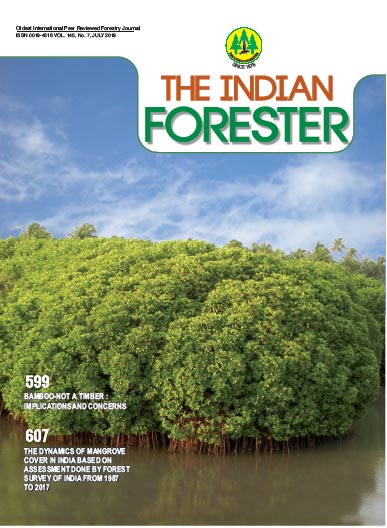A Rapid Assessment of Annual Grassland Fire using Remote Sensing and GIS in Keibul Lamjao National Park, Manipur
DOI:
https://doi.org/10.36808/if/2019/v145i7/147031Keywords:
Annual Grassland Fires, Remote Sensing, Brow-Antlered Deer, Loktak Lake, Floating Grass Land.Abstract
This paper analysed the pattern and extent of controlled fire in the floating grasslands of Keibul Lamjao National Park, Manipur, which is home to the endemic and endangered brow antlered deer (Rucervus eldi eldi). The grassland is controlled burnt every year as a part of park management. Sometimes the fire spreads extensively. The extent of the fire in 2017 was analysed using remote sensing data utilizing imageries from Indian Remote Sensing satellites and Landsat data. The fire scars were also compared with NASA's VIIRS active fire pixel data pertaining to the period. About 53.38% of the total grassland area of the park had been effected by fire. The time-series (from 2001 to 2017) analysis of annual fires in the park showed that on an average about 300 to 350 ha of the park was burnt every year with the highest area being in 2017, followed by 2009. Considering the potential ecological impact of this annual practice, some new management strategies which will be ecologically sound, economically feasible and technically simple have been suggested for improving the habitat condition of the park for better survival of the endemic deer.References
Leima T.S., Pebam R. and Hussain S.A. (2008). Dependence of lakeshore communities for livelihood on the floating grasslands of Keibul Lamjao National Park, Manipur, India. In: Proceedings of Taal 2007: The 12th World lake Conference, 29th Oct. -2th Nov., 2007, 2088-2090 pp.
Pebam R. (2011). Mapping of Keibul Lamjao National Park, Manipur. NESAC-SR-86-2011, 13p.
Pebam R., Sanggaileima T. and Sudhakar S. (2015). Changes in the habitat of Sangai: A concern for survival of the Brow antlered deer. Presented at National Workshop on 'Conservation and Sustainable Management of Sangai', IBSD, Imphal, 16-17 April 2015.
Shamungou K. (2007). Manipur brow antlered Deer: red alert. Tigerpaper, 21(1): 8-11.
Shamungou K. (2010). Endangered, Manipur Brow Antlered Deer. Department of Forest, Government of Manipur. 185p.
Singh H.T. (1991). Bioecology of the seriously endangered Brow-antlered deer (Cervus eldi eldi) in the only natural habitat Keibul Lamjao of Manipur with special reference to its conservation. Final Technical Report to the Department of Environment, Government of India, 126p.
Singh K.S. (1992). Wildlife in Manipur. Sangai Publications. Nambol. Manipur. 229p.
Singh S.S. (2002). Vegetation and Phumdi of Keibul Lamjao National Park. In: Trishal, C. L. and Manihar, Th. (eds.): Management of Phumdis in Loktak Lake, Proceedings of a Workshop, January 22nd and-24th
Thounaojam S.L. (2014). A Study on People Protected Area Interface at Keibul Lamjao National Park, Manipur. Ph. D. Thesis, Forest Research Institute University, Dehradun. 158p.
Downloads
Downloads
Published
How to Cite
Issue
Section
License
Unless otherwise stated, copyright or similar rights in all materials presented on the site, including graphical images, are owned by Indian Forester.





